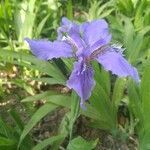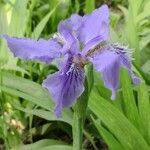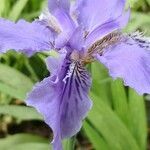Rhizomes creeping, thick. Roots slender. Leaves mainly in basal fans, yellowish green, broadly sword-shaped, curved, 15--50 × 1.5--3.5 cm, base surrounded by fibers. Flowering stems 1-or 2-branched, 20--40 cm, 1-or 2-leaved; spathes 2 or 3, green, lanceolate, 3.5--7.5 × 2--2.5 cm, 1-or 2-flowered, apex acuminate. Flowers bluish violet, ca. 10 cm in diam.; pedicel to 1 cm. Perianth tube slender, to 3 cm; outer segments mottled darker around conspicuous, white, irregularly toothed crest, broadly ovate, 5--7 × ca. 4 cm, apex retuse; inner segments spreading horizontally at anthesis, elliptic, 4.5--5 × ca. 3 cm. Stamens ca. 2.5 cm; anthers bright yellow. Ovary cylindric, 1.8--2 cm. Style branches pale bluish violet, ca. 3.5 cm. Capsule ellipsoid or obovoid, 4.5--6 × 2--2.5 cm. Seeds black-brown, pyriform, with very small aril. Fl. Apr--May, fr. Jun--Aug. 2 n = 24, 28, 32.
More
A fleshy stemmed iris. The roots are slender and there is a thick creeping rhizome. The leaves are broad and pale blue. The leaves are in fan shaped arrangements from the base. They are broadly sword shaped and curved and 15-50 cm long by 204 cm wide. The flowering stems have 1 or 2 branches and are 20-40 cm long. The flowers are somewhat flattened and lilac blue. They are 10 cm across.



